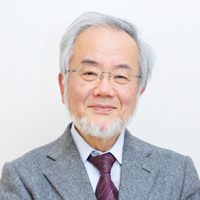Title of Presentation
“Autophagy revealed from studies on tiny cell, yeast”
Life is maintained through metabolic equilibrium – a continuous cycle between synthesis and degradation. While synthesis garnered much interest among the research community for many years, the study of degradation within cells remained neglected for a long time. After the important discovery of the lysosome, electron microscopic studies in the 1960s uncovered a process called autophagy, in which a cell transports its own proteins to the lysosome for degradation. However, for many years this phenomenon, which depends on complex membrane dynamics, remained poorly understood at the molecular level.
I was interested in the function of yeast vacuoles and discovered transport systems for amino acids and cells on the vacuolar membranes, together with the source of their driving force, V-ATPase. I then started a research project in 1988 to determine how acidic vacuoles, which contain various degrading enzymes, actually degrade things. I found that nitrogen starvation cells triggered delivery of cytoplasmic components to vacuoles in yeast. In addition, electron microscopic observation revealed that this process had a similar mechanism to the membrane dynamics found in autophagy in animal cells. Using the advantages present in yeast, I conducted genetic analyses and successfully isolated many autophagy-defective mutants. I also demonstrated that 18 ATG gene clusters are essential for the unique membrane dynamics called autophagosome formation. Many of these genes are also conserved in animals and plants, which suggests that autophagy was acquired at an early stage in the emergence of eukaryotes. Identification of these genes drastically changed the quality of conventional autophagy research. Genetic engineering has greatly advanced understanding of the physiological roles of autophagy at the cellular level and in vivo in animals and plants. New findings continue to be reported on a regular basis. Autophagy is characterized by its ability to degrade large structures, such as supramolecular structures and organelles, as well as proteins. Research has revealed that autophagy is involved in intracellular clearance, quality and quantity control of organelles, infection prevention, development, aging, and various illnesses in addition to survival during starvation through the supply of nutrients such as amino acids. Thus, degradation is now understood to be a function essential for life.
As part of cellular biology, the membrane phenomenon of autophagy has now attracted the attention of researchers and has gradually come to be better understood. However, this research field is still developing; even in yeast, unsolved problems are piling up, such as inducing conditions, signal transduction, which substrates are degraded, how the process works in vacuoles and what is produced, and how influences metabolism of degradation products after their transport to the cytoplasm. I would like to review my research of 30 years, introduce current findings, and discuss prospects for the future.
Profile
- Web Site URL
- Ohsumi Lab., Tokyo Institute of Technology
Ohsumi Frontier Science Foundation - A brief Biography
-
1963.3. Graduated from Fukuoka Prefectural Fukuoka High School 1967.3. B.Sc., Department of Basic Science, College of Arts and Sciences, The Univ. of Tokyo 1969.3. M.Sc., Graduate School of Science, The Univ. of Tokyo 1974.11. Graduated from Graduate School of Science, The Univ. of Tokyo 1974.12. Postdoctoral Fellow, Rockefeller Univ., USA 1977.12. Research Associate, Faculty of Science, The Univ. of Tokyo 1986.7. Lecturer, Faculty of Science, The Univ. of Tokyo 1988.4. Associate Professor, College of Arts and Sciences, The Univ. of Tokyo 1996.4. Professor, National Institute for Basic Biology, Okazaki National Research Institutes 2009.4. Specially Appointed Professor, Integrated Research Institute, Tokyo Inst. of Technology 2014.5. Honorary Professor, Tokyo Inst. of Technology (to date) 2016.12. Distinguished Specially Appointed Professor, Institute of Innovative Research, Tokyo Inst. of Technology (to date) - Details of selected Awards and Honors
-
2005.6. Fujihara Award 2006.7. Japan Academy Prize 2009.1. Asahi Prize 2012.11. Kyoto Prize 2013.9. Thomson Reuters Citation Laureate 2015.10. Canada Gairdner International Award 2015.12. International Prize for Biology 2016.11. Order of Culture 2016.12. Breakthrough Prize in Life Sciences 2016.12. The Nobel Prize in Physiology or Medicine - A list of selected Publications
-
Ohsumi, Y., and Anraku, Y. Active transport of basic amino acids driven by a proton motive force in vacuolar membrane vesicles of Saccharomyces cerevisiae. J. Biol. Chem., 256, 2079-2082 (1981)
Kakinuma, Y., Ohsumi, Y., and Anraku, Y. Properties of H+-translocating adenosine triphosphatase in vacuolar membranes of Saccharomyces cerevisiae. J. Biol. Chem., 256, 10859-10863 (1981)
Takeshige, K., Babe, M., Tsuboi, S., Noda, T., and, Ohsumi Y. Autophagy in yeast demonstrated with proteins-deficient mutants and its conditions for induction. J. Cell Biol., 119, 301-311 (1992)
Baba, M., Takeshige, K., Baba, N., and Ohsumi. Y. Ultrastructural analysis of the autophagic process in yeast: detection of autophagosomes and their characterization. J. Cell Biol., 124, 903-913 (1994)
Tsukada, M., and Ohsumi, Y. Isolation and characterization of autophagy-defective mutants of Saccharomyces cerevisiae. FEBS Lett., 333, 169-174 (1993)
Mizushima, N., Noda, T., Yoshimori, T., Tanaka, T., Ishii, T., George, M. D. Klionsky, D. J., Ohsumi, M., and Ohsumi, Y. A protein conjugation system essential for autophagy. Nature, 395, 395-398 (1998)
Ichimura, Y., Kirisako, T., Takao, T., Satomi, Y., Shimonishi, Y., Ishihara, N., Mizushima, N., Tanida, I., Kominami, E., Ohsumi, M., Noda, T. and Ohsummi, Y. A ubiquitin-like system mediates protein lipidation. Nature, 408, 488-492 (2000)
Kabeya, Y., Mizushima, N., Ueno, T., Yamamoto, A., Kirisako, T., Noda, T., Kominami, E., Ohsumi, Y., and Yoshimori, T. LC3, a mammalian homologue of yeast Apg8p is localized in autophagosome membranes after processing. EMBO J., 19, 5720-5728, (2000)
Suzuki, K., Kirisako, T., Kamada, Y., Mizushima, N., Noda, T. and Ohsumi, Y. The pre-autophagosomal structure organized by concerted functions of APG genes is essential for autophagosome formation. EMBO J., 20, 5971-5981 (2001)
Nakatogawa, H., Ichimura, Y., and Ohsumi Y. Atg8, a ubiquitin-like protein required for autophagosome formation, mediates membrane tethering and hemifusion. Cell, 130, 165-178 (2007)






